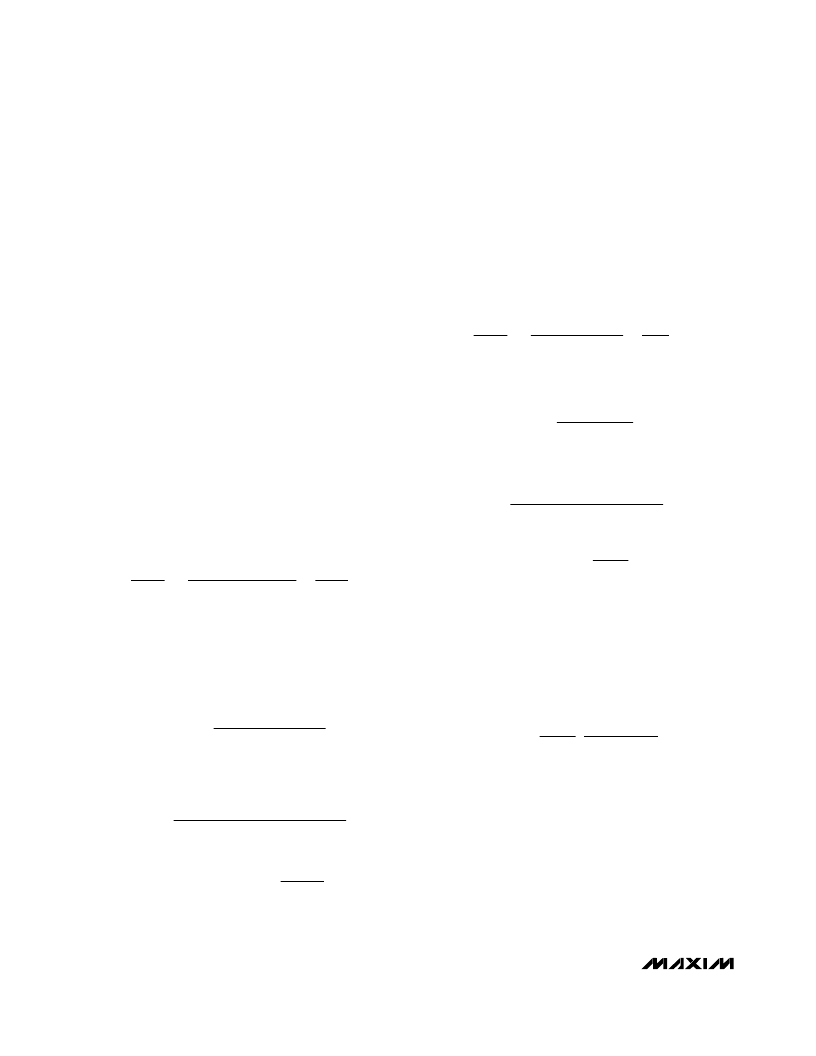- 您現(xiàn)在的位置:買賣IC網(wǎng) > PDF目錄383513 > MAX8740 (Maxim Integrated Products, Inc.) TFT-LCD Step-Up DC-DC Converter PDF資料下載
參數(shù)資料
| 型號: | MAX8740 |
| 廠商: | Maxim Integrated Products, Inc. |
| 元件分類: | DC/DC變換器 |
| 英文描述: | TFT-LCD Step-Up DC-DC Converter |
| 中文描述: | TFT-LCD升壓型DC-DC轉(zhuǎn)換器 |
| 文件頁數(shù): | 8/12頁 |
| 文件大?。?/td> | 341K |
| 代理商: | MAX8740 |

M
TFT-LCD Step-Up DC-DC Converter
8
_______________________________________________________________________________________
The equations used here include a constant LIR, which
is the ratio of the inductor peak-to-peak ripple current
to the average DC inductor current at the full load cur-
rent. The best trade-off between inductor size and cir-
cuit efficiency for step-up regulators generally has an
LIR between 0.3 and 0.5. However, depending on the
AC characteristics of the inductor core material and the
ratio of inductor resistance to other power path resis-
tances, the best LIR can shift up or down. If the induc-
tor resistance is relatively high, more ripple can be
accepted to reduce the number of turns required and
increase the wire diameter. If the inductor resistance is
relatively low, increasing inductance to lower the peak
current can decrease losses throughout the power
path. If extremely thin high-resistance inductors are
used, as is common for LCD panel applications, the
best LIR can increase to between 0.5 and 1.0.
Once a physical inductor is chosen, higher and lower
values of the inductor should be evaluated for efficien-
cy improvements in typical operating regions.
Calculate the approximate inductor value using the typ-
ical input voltage (V
IN
), the maximum output current
(I
OUT(MAX)
), the expected efficiency (
η
TYP
) taken from
an appropriate curve in the
Typical Operating
Characteristics
, and an estimate of LIR based on the
above discussion:
Choose an available inductor value from an appropriate
inductor family. Calculate the maximum DC input cur-
rent at the minimum input voltage V
IN(MIN)
using con-
servation of energy and the expected efficiency at that
operating point (
η
MIN
) taken from an appropriate curve
in the
Typical Operating Characteristics
:
I
V
IN MIN
Calculate the ripple current at that operating point and
the peak current required for the inductor:
V
L
×
The inductor’s saturation current rating and the
MAX8740’s LX current limit (I
LIM
) should exceed I
PEAK
,
and the inductor’s DC current rating should exceed
I
IN(DC,MAX)
. For good efficiency, choose an inductor
with less than 0.1
series resistance.
Considering the typical operating circuit, the maximum
load current (I
OUT(MAX)
) is 900mA with a 13.5V output
and a 5V typical input voltage. Choosing an LIR of 0.35
and estimating efficiency of 85% at this operating point:
Using the circuit’s minimum input voltage (4.5V) and
estimating efficiency of 85% at that operating point:
The ripple current and the peak current are:
Output Capacitor Selection
The total output voltage ripple has two components: the
capacitive ripple caused by the charging and discharg-
ing of the output capacitance, and the ohmic ripple due
to the capacitor’s equivalent series resistance (ESR):
V
V
RIPPLE
RIPPL( )
=
where I
PEAK
is the peak inductor current (see the
Inductor Selection
section). For ceramic capacitors,
the output voltage ripple is typically dominated by
V
RIPPLE(C)
. The voltage rating and temperature charac-
teristics of the output capacitor must also be considered.
V
V
I
C
V
V
V
and
V
I
R
RIPPLE ESR
RIPPLE( )
OUT
OUT
OUT
OUT OSC
IN
RIPPLE ESR
PEAK
ESR COUT
(
+
,
(
)
(
)
)
≈
≈
I
V
H
V
V
V
MHz
A
I
A
A
A
RIPPLE
PEAK
.
μ
(
×
.
4 5
1 2
)
.
.
0 93
3 2
+
.
3 7
=
≈
=
≈
4 5
12 5
13 5
2 7
0 93
2
I
A
V
V
A
IN DC MAX
(
,
)
.
.
3 5
0 85
3 2
=
≈
0 9
4 5
L
V
.
V
V
V
A
MHz
H
.
.
1 2
.
.
2 7
=
≈
μ
5
13 5
13 5
0 9
5
0 85
0 35
2
I
I
I
PEAK
IN DC MAX
(
RIPPLE
2
+
,
)
=
I
V
V
V
f
RIPPLE
IN MIN
(
OUT
IN MIN
(
OUT
OSC
(
×
)
)
)
=
I
V
IN DC MAX
(
OUT MAX
(
OUT
MIN
,
)
)
(
)
× η
=
×
L
V
V
V
V
I
f
LIR
IN
OUT
OUT
(
IN
OSC
OUT MAX
TYP
)
×
=
2
η
相關(guān)PDF資料 |
PDF描述 |
|---|---|
| MAX8740ETB | TFT-LCD Step-Up DC-DC Converter |
| MAX878LCPA | Analog IC |
| MAX8710 | LCD display panel power supply TFT Monitor TV |
| MAX8711 | LCD display panel power supply TFT Monitor TV |
| MAX8712 | LCD display panel power supply TFT Monitor TV |
相關(guān)代理商/技術(shù)參數(shù) |
參數(shù)描述 |
|---|---|
| MAX8740ETB | 制造商:Maxim Integrated Products 功能描述:LOW COST LCD MONITOR PANEL POWER SU - Rail/Tube |
| MAX8740ETB+ | 制造商:Maxim Integrated Products 功能描述:- Rail/Tube |
| MAX8740ETB+T | 功能描述:LCD 驅(qū)動器 TFT-LCD Step-Up DC/DC Converter RoHS:否 制造商:Maxim Integrated 數(shù)位數(shù)量:4.5 片段數(shù)量:30 最大時鐘頻率:19 KHz 工作電源電壓:3 V to 3.6 V 最大工作溫度:+ 85 C 最小工作溫度:- 20 C 封裝 / 箱體:PDIP-40 封裝:Tube |
| MAX8740ETB-T | 功能描述:LCD 驅(qū)動器 RoHS:否 制造商:Maxim Integrated 數(shù)位數(shù)量:4.5 片段數(shù)量:30 最大時鐘頻率:19 KHz 工作電源電壓:3 V to 3.6 V 最大工作溫度:+ 85 C 最小工作溫度:- 20 C 封裝 / 箱體:PDIP-40 封裝:Tube |
| MAX8740EUB+ | 制造商:Maxim Integrated Products 功能描述:- Rail/Tube |
發(fā)布緊急采購,3分鐘左右您將得到回復。